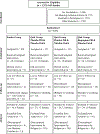Smoking abstinence symptoms across 67 days compared with randomized controls-Moderation by nicotine replacement therapy, bupropion, and negative-affect traits
- PMID: 30920255
- PMCID: PMC9559614
- DOI: 10.1037/pha0000278
Smoking abstinence symptoms across 67 days compared with randomized controls-Moderation by nicotine replacement therapy, bupropion, and negative-affect traits
Abstract
Accurate knowledge of negative affect (NA)-related smoking abstinence symptoms (SAS) severity and duration and their moderation by pharmacotherapy and NA-related personality traits is critical for efficacious treatments given that elevated state and trait NA are predictors of relapse. However, SAS severity, duration, and moderation are not well characterized. To date, the longest randomized controlled trial (RCT) of NA-related SAS using randomized delayed-quit smoking controls only examined symptoms across 45 days, despite clinical evidence that SAS may last longer. The present RCT assessed SAS across 67 days in dependent smokers (N = 95) who were randomized either to quit or to delay quitting for the course of the trial. The quit group was further randomized to receive either nicotine replacement therapy (NRT), bupropion (BUP), or placebo. Abstinence-related increases in anger-irritability, depressive, anxiety, and general NA symptoms did not resolve relative to the delayed quit group (DQG) levels across the 67 days in any of the 3 quit groups, though craving fell to below DQG and prequit levels. While NRT attenuated Day 3 SAS relative to BUP and placebo, BUP and NRT generally did not reduce SAS. High scores on trait measures of NA/neuroticism predicted greater increases in and duration of NA-related SAS, potentially indicating that smoking abstinence unmasks affective symptoms. Positive affect was not impacted by abstinence or treatment. The results support the views that (a) prequit baseline values are not a valid index of NA SAS recovery, and (b) on average, NA-related SAS take longer than 67 days to resolve. (PsycINFO Database Record (c) 2019 APA, all rights reserved).
Trial registration: ClinicalTrials.gov NCT01048944.
Conflict of interest statement
None of the authors have any conflicts of interest.
Figures









References
-
- Beck AT, & Steer RA (1987). Beck Depression Inventory Manual. San Antonio, TX: The Psychological Corporation.

